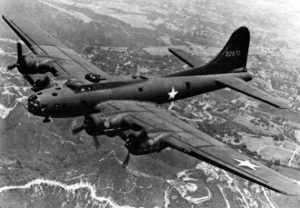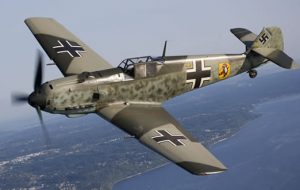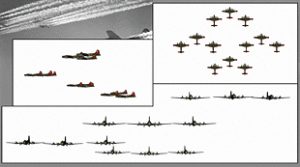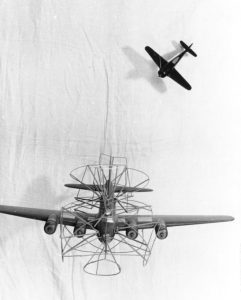.50 caliber m2

 When the B-17 was built, it was designed to be a formidable weapon against the enemy, namely the Nazis and the Japanese. Early on, before long-range fighter escorts came into being, B-17s had only their .50 caliber M2, the B-17s were on their own out there. Still, the B-17 was not defenseless. With those .50 caliber M2s, the crew had the ability to fire at the enemy from every direction…almost. The job of the Messerschmitt fighters was to take down the B-17s. The Messerschmitt fighter planes were designed to break world air speed records. They were also the hope of the Germans to take down the B-17s. Still, there were all those guns to deal with. Luftwaffe fighter pilots agreed that attacking a B-17 combat box formation to encountering a fliegendes Stachelschwein, “flying porcupine,” with dozens of machine guns in a combat box aimed at them from almost every direction. The biggest downfall of the B-17 bombing formation was that they had to fly straight, making them vulnerable to German flak. It was the first line of defense the Germans had when the bombers came in.
When the B-17 was built, it was designed to be a formidable weapon against the enemy, namely the Nazis and the Japanese. Early on, before long-range fighter escorts came into being, B-17s had only their .50 caliber M2, the B-17s were on their own out there. Still, the B-17 was not defenseless. With those .50 caliber M2s, the crew had the ability to fire at the enemy from every direction…almost. The job of the Messerschmitt fighters was to take down the B-17s. The Messerschmitt fighter planes were designed to break world air speed records. They were also the hope of the Germans to take down the B-17s. Still, there were all those guns to deal with. Luftwaffe fighter pilots agreed that attacking a B-17 combat box formation to encountering a fliegendes Stachelschwein, “flying porcupine,” with dozens of machine guns in a combat box aimed at them from almost every direction. The biggest downfall of the B-17 bombing formation was that they had to fly straight, making them vulnerable to German flak. It was the first line of defense the Germans had when the bombers came in.
In a 1943 survey, the USAAF found that over half the bombers shot down by the Germans had left the protection of the main formation. The Germans needed a training plan. The United States developed the bomb-group formation, which evolved into the staggered combat box formation in which all the B-17s could safely cover any others in their formation with their machine guns, making a formation of bombers a dangerous target to engage by enemy fighters. The Messerschmitt fighters were fast, but they could not just fly at the formation. They would be shot down for sure. So, they looked for the bomber that had been hit and had to pull out of formation. Then they would move in for the kill. Moreover, German fighter aircraft later developed the tactic of high-speed strafing passes rather than engaging with individual aircraft to inflict damage with minimum risk. It was a way of not fully engaging the “flying porcupine.” As a result, the B-17s’ loss rate was up to 25% on some early missions. They needed something more to provide a kind of shield against the enemy.


It was not until the advent of long-range fighter escorts (particularly the North American P-51 Mustang) and the resulting degradation of the Luftwaffe as an effective interceptor force between February and June 1944, that the B-17 became strategically potent. They needed the P-15 Mustang to keep the Messerschmitts off of them. So in the end, the German training didn’t do them much good against the “flying porcupine.”

